


German, two 16th century woodcuts illustrating the production
of woodcuts. First: a man draws
a design for the image. Second:
a man uses a burin to
cut the block of wood to be inked.
Other examples:
Albrecht Dürer (German, 1471-1528), The Adoration of the Magi, 1511, woodcut, Michael C. Carlos Museum, Emory U, Atlanta, GA. See Northern Renaissance.
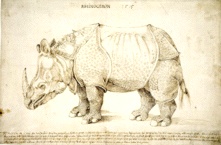
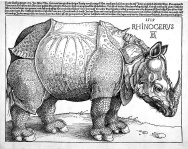
Albrecht Dürer, The Rhinoceros, this drawing and
this woodcut, 1515, British Museum, London.
"Dürer produced this drawing and woodcut from reports of the arrival in Lisbon of an Indian rhinoceros in May of 1515. No rhinoceros had been seen in Europe for over 1000 years, so Dürer had to work solely from these reports. He covered the creature's legs with scales and the body with hard, patterned plates. Perhaps these features interpret lost sketches, or even the text, which states, '[The rhinoceros] has the color of a speckled tortoise and it is covered with thick scales'. So convincing was Dürer's fanciful creation that for the next 300 years European illustrators borrowed from his woodcut, even after they had seen living rhinoceroses without plates and scales." See nature and texture.

Baldung Grien (Hans Baldung) (German, 1484-1545), The Three Fates, 1513, woodcut; sheet: 8 7/16 x 5 inches (21.43 x 12.7 cm), Los Angeles County Museum of Art.
Hans Holbein The Younger (German, 1497/98-1543), Death and the Knight, 1538, woodcut, 65 x 50 mm, Spencer Museum, KS. Click here for a 101 k image.

Michael Ostendorfer (German, active 1520-1549),
written by Petrus Apianus, Astronomicum Caesareum, 1540, woodcuts,
hand-colored, Metropolitan Museum of Art, NY.

France, Troyes, Dance of Death, 16th century, incunabulum, illustrated with hand-colored woodcuts, Saxon State Library, Dresden, Germany. Based on a fourteenth-century morality poem by an unidentifiable author, the Dance of Death evolved into a set of illustrated verses depicting a dialogue between Death and people of all social ranks. The theme was very popular in 15th and 16th century Christian Europe, reminding the living that rank and station in life were meaningless in the face of death. The illustrations show representations of ecclesiastical and secular society being carried off by Death. The pages displayed here show the Pope, the Emperor, a cardinal, and a king. See vanitas.

Katsushika Hokusai (Japanese, 1760-1849),
The Great Wave Off Kanagawa, from "Thirty-six
Views of Mount Fuji", Edo period, 1823-29, color woodcut, 10 x 15 inches, Metropolitan
Museum of Art, NY. See Japanese
art.
Ando Hiroshige (Japanese, 1797-1858)
Jose Guadalupe Posada (Mexican, 1852-1913), La Calavera, no date, black and white woodcut, 14 x 10 1/2 inches, Arizona State U Art Museum, Tempe, AZ. See Mexican art.

Edvard Munch (Norwegian, 1863-1944), Madonna, 1895-1902, lithograph and woodcut, complete: 23 3/4 x 17 1/2 inches (60.5 x 44.5 cm), edition: c. 250, Museum of Modern Art, NY. This was exhibited in the influential Armory Show of 1913. See Expressionism, madonna, and Symbolism.
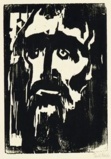
Emil Nolde (German, 1867-1956), Prophet, 1912, woodcut, edition
of 20-30, 12 5/8 x 8 3/4 inches (32.1 x 22.2 cm), Museum of Modern
Art, NY. See Die Brücke
and Expressionism.

Lyonel Feininger (American, 1871-1956), Ville
am Strande. 4., woodcut, 10 1/2 x 7 3/8 inches, Tehran
Museum of Contemporary Art, Iran.

Ernst Ludwig Kirchner (German, 1880-1938),
Bathers Throwing Reeds, from the portfolio
Brücke V, 1909-10, woodcut, complete: 7 7/8 x 11
1/2 inches (20 x 29.2 cm). Publisher: Künstlergruppe Brücke,
Dresden; edition: c. 68.
See Die Brücke and Expressionism.
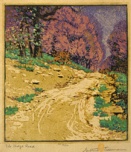
Gustave Baumann (American, 1881-1971), The Ridge Road,
1918, color woodcut (six blocks) on fibrous laid paper, Hood Museum of Art, Dartmouth College, NH.
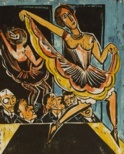
Max Pechstein (German, 1881-1955), Dancer Reflected in a Mirror, 1923, woodcut,
edition of 51, 19 9/19
x 15 3/4 inches (49.6 x 40 cm), Museum of Modern Art, NY. Publisher:
Euphorian Verlag, Berlin. See Expressionism, mirror, and self-portrait.
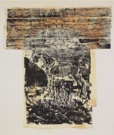
Anselm Kiefer (German, 1945-), Grane, 1980-93,
unique woodcut with paint additions, 9 feet 1 1/16 inches x 8
feet 2 1/2 inches (277.1 x 250.3 cm), Museum of Modern Art, NY.
Also see block printing, bookplate, chiaroscuro, and wood engraving.
https://inform.quest/_art